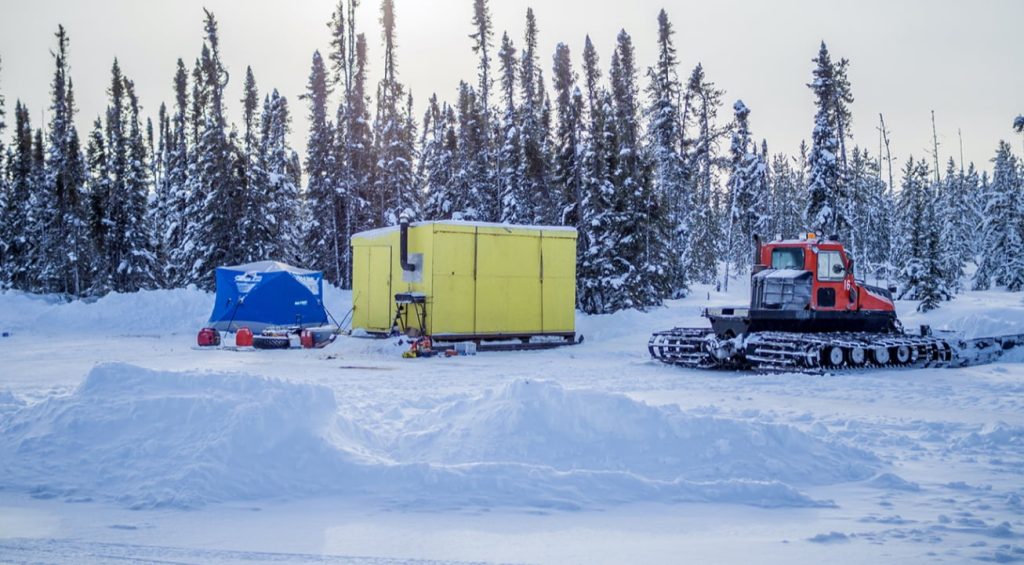IsoEnergy commences Larocque East Project winter exploration program, Saskatchewan

IsoEnergy Ltd. [TSX: ISO; OTCQX: ISENF] reported the start of its 2025 winter exploration program in the eastern Athabasca Basin, northern Saskatchewan, Canada designed to build on the company’s successful 2024 season.
A total of 8,800 metres of drilling are planned on the Larocque East project, which contains the high-grade Hurricane deposit, with mobilization to the project underway. The focus of the program is twofold, with drilling to test resource expansion potential near the Hurricane deposit and the evaluation of greenfield targets along the Larocque Trend east of Hurricane. Geophysical surveys are also planned on the Hawk, Evergreen and East Rim projects to advance these early-stage projects to the drill ready stage. A total budget of $5.3 million has been approved for the winter exploration programs in the Athabasca Basin.
Highlights – Hurricane Deposit Resource Expansion: Approximately 2,800 metres of drilling in seven holes will target gaps in historic drilling near the Hurricane deposit and 2024’s Target Area B.
Drilling will test areas where prior results indicate geochemical anomalies and alteration associated with fault extensions that control mineralization within the Hurricane resource.
Greenfield Targets Along the Larocque Trend: Up to 6,000 metres of drilling in 15 holes will test a six-km segment of the Larocque Trend east of the Hurricane deposit.
Drilling will focus initially on three target areas (D, E, and F) identified through 2024’s integration of geophysical and geochemical data. The trend on which these target areas lie extends eastward on to IsoEnergy and Purepoint Uranium’s joint venture announced late last year.
Geophysical Surveys on Highly Ranked, Early-Stage Projects: Ground geophysical surveys are planned on the East Rim, Evergreen, and Hawk projects to advance targets to the drill-ready stage.
Dan Brisbin, Vice President of Exploration, stated, “We are eager to launch our winter exploration program, which includes testing deposit expansion targets around the margins of the Hurricane deposit and exploring for new deposits along the highly prospective Larocque Trend. Targets on this corridor were identified through a comprehensive integration of drill hole geology, geochemistry, alteration mineralogy, and geophysical data, including electromagnetic, DC resistivity, and ANT surveys. The approach builds on the understanding that Athabasca uranium deposits often consist of multiple zones distributed along trends several kilometres in length, suggesting the potential for additional discoveries beyond the Hurricane deposit. Drilling in the easternmost target areas of the Larocque East project will also enhance our understanding of favourable structural trends extending onto the Turnor Lake project to the east, where our joint venture partner, Purepoint Uranium, is advancing plans for future drilling.”
Drilling will commence with testing resource expansion targets near the Hurricane deposit and between it and 2024 Target Area B. Review of 2024 and past drill results has highlighted gaps in drill hole patterns where nearby holes intersected indicative geochemistry and alteration along projected extensions of faults which control mineralization within the Hurricane resource.
Historical results on the south side of the Hurricane deposit are encouraging, with drill hole LE22-115A intersecting 1% U₃O₈ over 2.0 m and LE21-101 intersecting 0.6% U₃O₈ over 4.5 m, including a higher-grade interval of 3.1% U₃O₈ over 0.5 m.
These intersections are proximal to a fault that controls a southern high-grade lens in the resource, underscoring the structural influence on mineralization and opening the possibility to extend the existing lens or identify additional mineralized lenses along this southern fault outside of the existing resource footprint.
Holes from the east end of the Hurricane resource footprint and to the east end of ambient noise tomography (ANT) target Area B drilled in 2024 have strong illite clay alteration and uranium partial (Up) geochemical signatures, and structural disruption so additional holes are planned to test drilling gaps in this area that is along the eastward strike extension of the faults that control the main portion of the Hurricane deposit.
Finally, review of historical drill hole data reveals that the northern faults at Hurricane – intersected in holes drilled from the north to intersect the deposit at depth (e.g. LE19-15) – remain largely untested at the unconformity, presenting a compelling target which will be tested this winter.
With addition of a second drill rig, drilling of greenfield targets are expected to proceed from west to east across the Larocque Trend, as drill trails are prepared. The Larocque Trend is an important regional structure that hosts the world-class Hurricane deposit and other notable high-grade occurrences including those on Cameco/Orano’s Dawn Lake joint venture.
IsoEnergy also provided an update in connection with the previously announced plan of arrangement with Anfield Energy Inc. While the outside date under the arrangement agreement has passed, IsoEnergy is continuing to consider the Arrangement and potential options and alternatives. IsoEnergy will update the market as soon as further information becomes available.
IsoEnergy is advancing its Larocque East Project in the Athabasca Basin, home to the Hurricane deposit, boasting the world’s highest grade Indicated uranium Mineral Resource.
IsoEnergy also holds a portfolio of permitted past-producing conventional uranium and vanadium mines in Utah with a toll milling arrangement in place with Energy Fuels Inc. These mines are currently on stand-by, ready for rapid restart as market conditions permit, positioning IsoEnergy as a near-term uranium producer.
